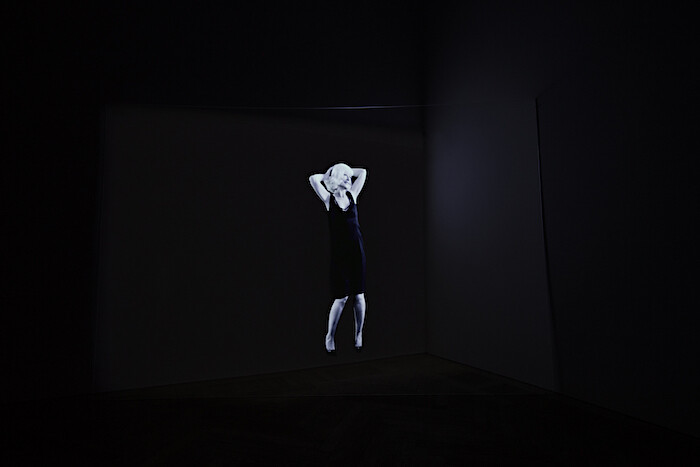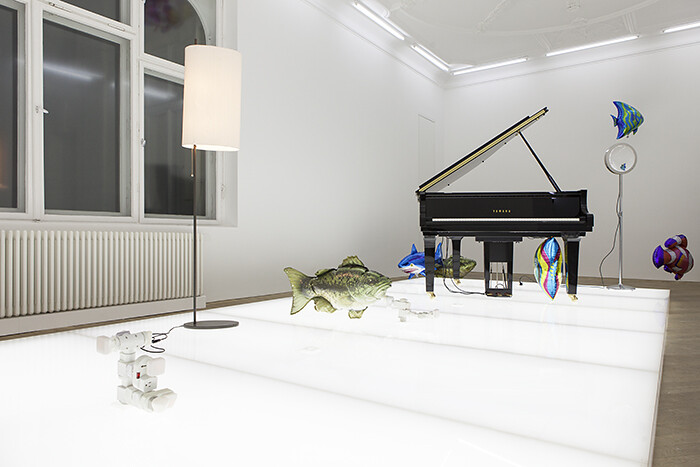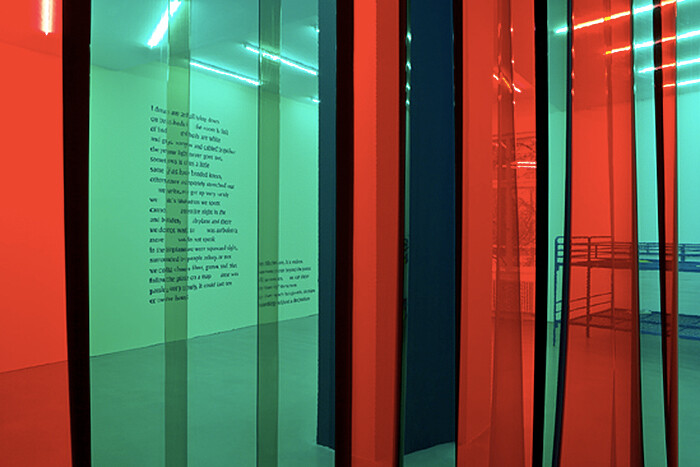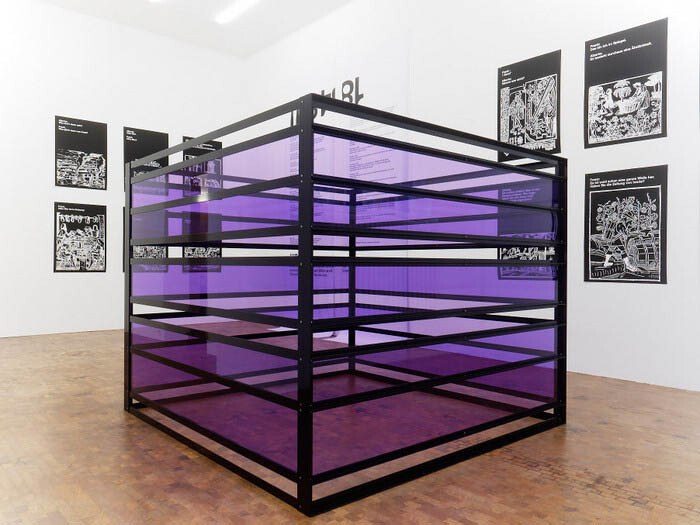Categories
Subjects
Authors
Artists
Venues
Locations
Calendar
Filter
Done
December 15, 2016 – Review
Dominique Gonzalez-Foerster’s “QM.15” and “Costumes & Wishes for the 21st Century”
Antje Stahl

I was sent into darkness. I couldn’t see a single thing. There was a fuzzy light right behind the gallery door illuminating press releases laid out on a small table, and a gallery staffer equipped with a small flashlight. But she simply pointed into the dark: “That way.” That way was Dominique Gonzalez-Foerster’s exhibition “QM.15” at Esther Schipper in Berlin. That way felt like a ghost hall.
I heard a female voice singing an aria, but I had to pass by a life-sized moving image of a woman in a white uniform, fumbling my way along, before I fell over a rope that prevented me from reaching its source: an apparition of Maria Callas. A holographic illusion, to be more precise, of Dominique Gonzalez-Foerster playing Maria Callas: Opera (QM.15) (2016).
I don’t have a particular passion for being blindfolded. I hate ghosts, and I also hate costumes. A day before Halloween, Berlin’s Schinkel Pavillon organized an event for people who are, I guess, excited about these things: a costume party as part of an exhibition. Produced by the artist in collaboration with the Berlin fashion designers BLESS and design studio Manuel Raeder, “Costumes & Wishes for the 21st Century” could be considered …
December 22, 2014 – Review
Philippe Parreno’s “quasi-objects” and “How Can We Tell the Dancers from the Dance”
Ana Teixeira Pinto

What do things want? The notion of animism is correlated with the problem of agency—who or what can be said to have volition. According to Norbert Wiener, “our consciousness of will in another person is just that sense of encountering a self-maintaining mechanism aiding or opposing our actions.” One can also define animism as a transfer of volition from the animate to the inanimate, through which life and liveliness shift from increasingly inert human bodies to increasingly energetic and inventive things.
Be it because of changes in pressure or temperature, the fish-shaped balloons in Philippe Parreno’s installation Quasi Objects: My Room is a Fish Bowl, AC/DC Snakes, Happy Ending, Il Tempo del Postino, Opalescent acrylic glass podium, Disklavier Piano (2014)—currently on view as a part of Parreno’s “quasi-objects” at Esther Schipper in Berlin—clearly want to escape. Sharks are the cheekiest: on the opening evening, one tried to follow us out, but was promptly captured by the doorman—that was his function, in fact, to make sure no fish would escape the premises. Another was found at the stairwell ceiling, apparently disillusioned with life on the run. The angelfish and the odd carp seemed to better conform, but maybe I am stereotyping.
“Quasi-objects” is …
May 14, 2012 – Review
Dominique Gonzalez-Foerster’s “Return to Noreturn”
Kirsty Bell

“Return to Noreturn” revisits Dominique Gonzalez-Foerster’s 2008 exhibition in the Turbine Hall of London’s Tate Modern. The anterior references and influences that are often implicated in her works are therefore doubled here, incorporating not only the original exhibition, but also the triggers—personal, literary, historical, cultural—that informed it. Add to this the fact that the Turbine Hall exhibition imagined a scenario projected 50 years into the future—its title was “TH 2058”—but that we are now invited to look back at it from the vantage point of 2012, and the complexity has been shifted up a gear: chronology seems to fold in on itself. With a characteristically light-fingered touch, Gonzalez-Foerster indicates this complexity without laboring it. And indeed for those viewers who, like me, had not seen the original exhibition, it has come to exist instead as a kind of dream-like shared memory.
The solipsistic title alone immediately establishes a framework of references for the exhibition, but rather than fixing intransient points, they work through concentrated evocation. A series of considered measures, or perhaps rather “moments” (a word the artist is fond of using), set the atmosphere. On entering the gallery, we are at once separated from the outside by passing through a …
July 14, 2010 – Review
Liam Gillick’s "1848!!!" at Esther Schipper, Berlin
Kirsty Bell

With an exhaustive monographic exhibition currently on show in Bonn, a lengthy touring retrospective recently over, and last year’s opinion-dividing outing in the Venice Biennale’s German Pavilion, not to mention the reams of printed matter and symposia that make up the productive phenomenon that is Liam Gillick, what can a small-scale gallery show have to offer?
“Three key components” of Gillick’s work, or so the press release tells us: “The beginning of a new research process; the re-presentation of an event and a new physical structure.” That the three components themselves appear baffling (at least to the uninitiated) is not unusual with Gillick’s work. It is essentially a given that the visible works, despite their glossy physical character, function rather as stand-ins for a discourse going on elsewhere: a broad, circling, theoretical mesh of questions, quotations, references, and collaborations. Although it is true to say that the exhibition consists of a series of black-and-white inkjet prints, an aluminum and Plexiglass structure, a large paper banner advertising a film, and a film projected large, this fact, it seems, largely misses the point.
This situation is immediately apparent when faced with the works themselves. Each of the black-and-white prints, for instance, combines an image …